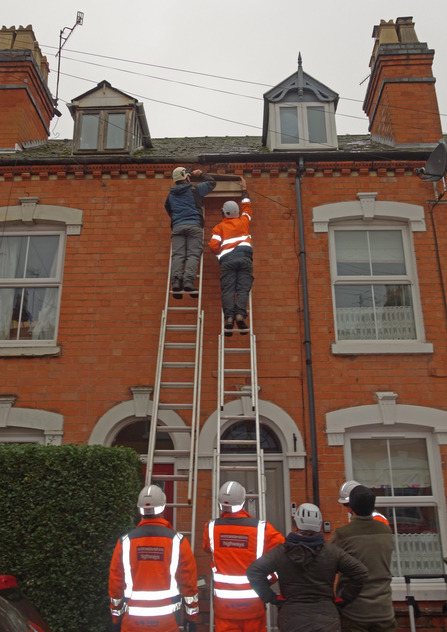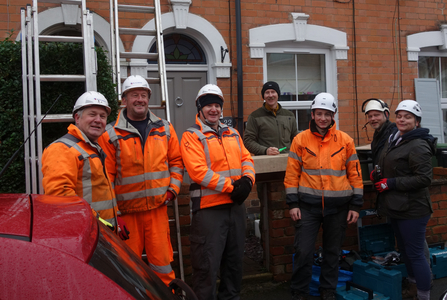It all started on a sweltering summers evening at Lansdowne Allotments. Local residents were conducting the Bugs, Bees and Broccoli survey for the Allotment Association and as the sun set the swifts were screaming over the rooftops of Worcester. We watched on, captivated by their aerial antics. Screaming parties of these magnificent birds were flying overhead, along the canal and through the narrow streets of the Arboretum.
Worcester's swifts
Worcester Envrionment Group and Arboretum Residents Association with a newly made swift box by Liz Yorke
Every May I start listening out for swifts, that first scream of the year indicating that they are back and summer is here. The fact that they take an incredible 14,000 mile commute to and from Africa just to be with us and nest under the eaves of our buildings never fails to amaze me. Yet they are gone by August! We have just a few short weeks to make their stay as good as we can.
Swift by Martyn Crookston
There are many remarkable facts about this truly global bird. Not only do they take on this staggering migration to breed, they also spend almost their entire lives on the wing. From the moment the young fledge from our roofs, these birds feed, sleep, bathe and even mate in the air. It might be three years before a fledgling lands again and this is only to nest. They can ascend up to 10,000 feet in the sky to sleep and catch up to 10,000 insects a day when feeding their young. Yet despite this fast paced existence, they are a long-lived species; 18 years is the current record. They are also faithful, returning each year to nest in the same place with the same partner. Imagine flying all that way to find that building renovations have blocked up your nest site.
As a species swifts are in trouble. It is estimated that nearly half of British swifts have been lost since 1995 with loss of nest sites and decline in aerial insects likely to be the major causes.
What could Arboretum residents do to help?
The answer to this started in the local pub with a ‘swift half’! A plan slowly came together to put up some swift boxes.
It needed to start with a survey. Over the summer of 2023 members of the Arboretum Residents Association and Worcester Canal Group took regular evening strolls to find out where swifts were already nesting. They are social birds, liking to nest in colonies and they have found that our architecture makes for brilliant nest sites. Truly urban birds. It was decided to put the new boxes up where the swifts can be together.

Putting up a swift box by Liz Yorke
At the same time the surveys were taking place, volunteers from Worcester Environment Group were busy making the swift boxes. Different designs for different houses and all with nest cups to encourage these fussy breeders to make a home for the summer.
One of the remarkable outcomes of the project is the number of people in the community that have given up their time to help out. Neighbours have got together and members of different community groups have collaborated with a shared purpose. A sociable experience for a sociable bird.
All that is left is to get the boxes up. We've made a start! Plenty of residents are keen to host boxes and ladder-trained volunteers from Worcester Environment Group are ready to go.

Swift box team by Liz Yorke
I can’t wait to see what happens. Patience is going to be required as it can often take a few years for the swifts to find the new boxes. But all good things have to start somewhere!




